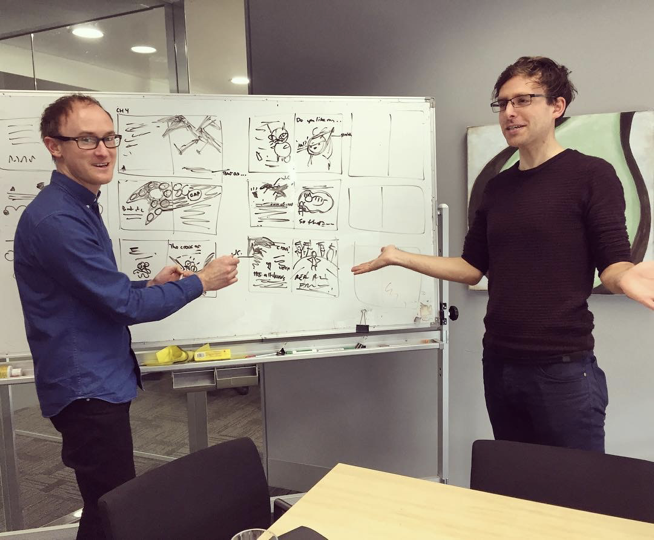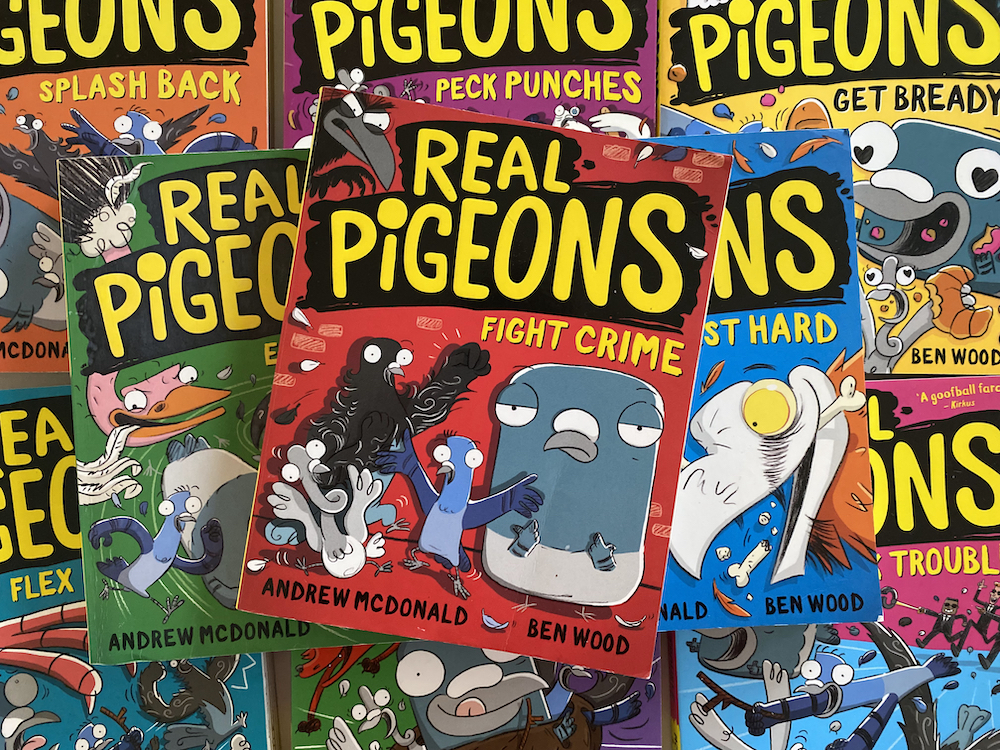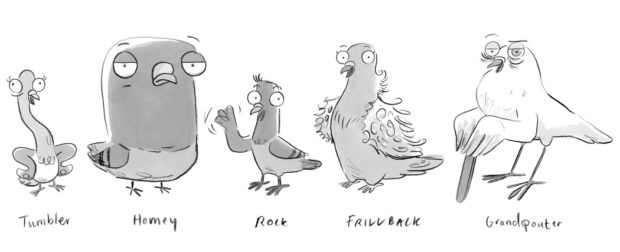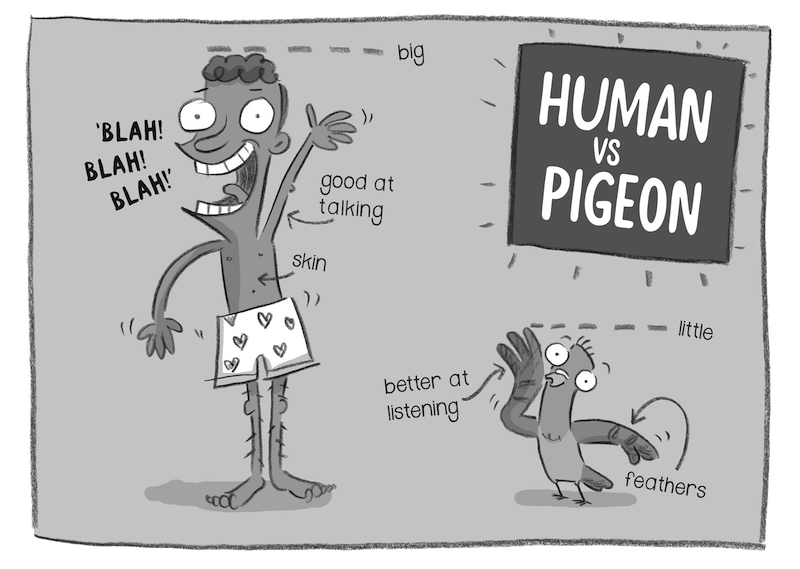When I wrote the first book in the Real Pigeons series, I was trying to write a funny book for kids about a bunch of fancy pigeons who solve mysteries by working together.
At the time, I had no idea that teamwork would become a central thematic tenet for the series. Nor did I suspect that the series would effectively become a great act of teamwork itself. A creative collaboration that would change my life – and illustrator Ben Wood’s life too.

I don’t envy the people whose job it is to put authors and illustrators together for book projects. There are so many things to consider. Will the author like the artwork? How will the artist engage with the story? Will their creative styles match? And perhaps most importantly – will the collaboration take the book to a whole new level that would otherwise be unachievable?
There’s no doubt in my mind that the Real Pigeons books are better because Ben and I developed an organic and productive creative partnership from the very outset – a partnership that was suggested by our Australian publishers.

When I first showed them a draft of Real Pigeons Fight Crime – the first book in the series – they immediately thought Ben might be able to draw some funny-looking pigeons. Ben has since told me that when he finished reading my manuscript, he said with some astonishment: ‘This is what the inside of my brain looks like!’
He sat down and started drawing pigeons right away.

As soon as I saw Ben’s pigeon illustrations I thought: ‘This isn’t what I imagined in my brain…it’s a hundred times better!’ Because Ben’s pigeons are unique, hilarious and so vibrant that sometimes when I’m looking at them I feel like I’m watching an animated TV show.
For creative collaborations to work, both parties need to have respect and empathy for each other – but also for the characters they are joint custodians of. I wrote Real Pigeons to get inside pigeons’ heads, tell their secret stories and show that any creature – no matter how big or small – can have an inner-world that is rich, complex and multi-dimensional.
Looking at Ben’s artwork it’s obvious he feels this empathy for the pigeons too. He often draws the world from their literal point-of-view, looking up at humans from street level – or navigating skies full of chimneys, trees and window-ledges. This gives the stories a cinematic look, rendering them simultaneously intimate and epic.

Sharing this empathy for our feathered characters is a big part of why our styles are so well-matched in Real Pigeons.
It also helps that Ben and I share a deep love for pigeon foods like bread, donuts, pies, cakes and biscuits. Yum!
We’re both incredibly proud of how Real Pigeons Fight Crime turned out. It features three mysteries, which our feathery heroes have to solve. The narratives are simple enough for newly independent readers to enjoy, while the illustrations make the book super accessible, encouraging readers along and improving their visual literacy skills too.
And crucially, these Real Pigeons stories are surprising.
When I am writing, I always have one, overriding objective – to surprise the reader.
That doesn’t mean I’m always making slime-slathered monsters leap from the shadows screaming ‘Surprise!’ (although that’s a valid narrative choice). I’m more interested in surprises that keep readers reading, because they can’t predict what will come next. These surprises can be plot twists, strange mysteries, quirky characters, weird situations, exaggerated reactions, unexpected riffs on tropes, subversions of genres and – of course – humour.
Humour is inherently surprisingly. What is a laugh but an expulsion caused when we find something to be unexpectedly joyful? The Real Pigeons books aim to surprise kids with all of these methods, but especially humour.
In Real Pigeons Fight Crime, there is a scene where Rock Pigeon decides that bats are really cool and he makes a bat costume out of found materials.

When Ben was illustrating that moment, I remember him saying to me, ‘I never thought I’d draw a pigeon, wearing a stocking, pretending to be a bat, dancing in a street. It’s so random and funny.’ And I thought, ‘Good! If Ben laughs here then hopefully the reader will too.’
When you see a funny moment in a Real Pigeons book, you’re basically looking at a conversation where Ben and I have tried to make each other laugh.
Like this one.

This was basically me saying, ‘Let’s show exactly why pigeons are better at crime-fighting than humans?’ And Ben replying, ‘Yes and let’s make the human naked except for some LOVE HEART pants!’
While lots of things aligned easily for Ben and I as we worked on Real Pigeons, the thing we actively worked to develop was the way the text and pictures intertwine.
Ben has illustrated over thirty children’s books and we’re both big readers of graphic novels and comics. So we took a format-agnostic approach to the book and did some storyboarding to work out the best way to lay out text and illustrations.
Depending on what needs to happen on any given page of a Real Pigeons book, we’ll use the style, genre or format that makes the joke or story beat work best. Sometimes this means the page will look like a chapter book. Sometimes, like a comic. Sometimes, like a picture book.
We always make sure the text is communicating major plot elements. The book has to work when being read aloud. But at the same time, the illustrations should never be just a visual echo of the text.

To tell the full story, to present all the clues, to tell as many jokes as possible, the words and pictures in a Real Pigeons book are integrated so that they flow effortlessly, combining to merely become the story.
So what is the secret to our creative collaboration?
For me, it comes down to a mutual respect of our creative skills, reciprocal empathy for the jobs we each have to perform and an openness to iterate and evolve ideas as we go. If I write a one-liner and Ben thinks of a better one-liner, then we use that line. If Ben draws something and I think it would work better drawn differently, then we explore that possibility. The story matters more than us as individuals.
Most of all, Ben and I enjoy making books together. If we ever stop having fun working together, we should stop. Because I’m certain that the books are fun to read because we’re having a ball putting them together.
Oh and it helps that we both really like pigeon food too!
This article was first published on writing.ie.
Find lots of Real Pigeons resources, activities and info online at realpigeons.com.